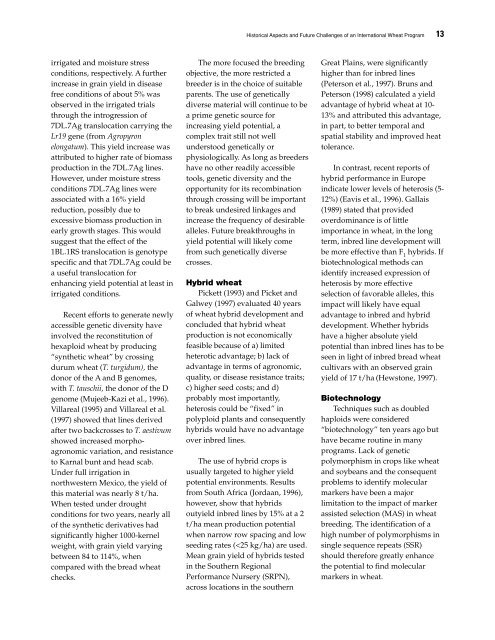Septoria and Stagonospora Diseases of Cereals - CIMMYT ...
Septoria and Stagonospora Diseases of Cereals - CIMMYT ...
Septoria and Stagonospora Diseases of Cereals - CIMMYT ...
You also want an ePaper? Increase the reach of your titles
YUMPU automatically turns print PDFs into web optimized ePapers that Google loves.
irrigated <strong>and</strong> moisture stress<br />
conditions, respectively. A further<br />
increase in grain yield in disease<br />
free conditions <strong>of</strong> about 5% was<br />
observed in the irrigated trials<br />
through the introgression <strong>of</strong><br />
7DL.7Ag translocation carrying the<br />
Lr19 gene (from Agropyron<br />
elongatum). This yield increase was<br />
attributed to higher rate <strong>of</strong> biomass<br />
production in the 7DL.7Ag lines.<br />
However, under moisture stress<br />
conditions 7DL.7Ag lines were<br />
associated with a 16% yield<br />
reduction, possibly due to<br />
excessive biomass production in<br />
early growth stages. This would<br />
suggest that the effect <strong>of</strong> the<br />
1BL.1RS translocation is genotype<br />
specific <strong>and</strong> that 7DL.7Ag could be<br />
a useful translocation for<br />
enhancing yield potential at least in<br />
irrigated conditions.<br />
Recent efforts to generate newly<br />
accessible genetic diversity have<br />
involved the reconstitution <strong>of</strong><br />
hexaploid wheat by producing<br />
“synthetic wheat” by crossing<br />
durum wheat (T. turgidum), the<br />
donor <strong>of</strong> the A <strong>and</strong> B genomes,<br />
with T. tauschii, the donor <strong>of</strong> the D<br />
genome (Mujeeb-Kazi et al., 1996).<br />
Villareal (1995) <strong>and</strong> Villareal et al.<br />
(1997) showed that lines derived<br />
after two backcrosses to T. aestivum<br />
showed increased morphoagronomic<br />
variation, <strong>and</strong> resistance<br />
to Karnal bunt <strong>and</strong> head scab.<br />
Under full irrigation in<br />
northwestern Mexico, the yield <strong>of</strong><br />
this material was nearly 8 t/ha.<br />
When tested under drought<br />
conditions for two years, nearly all<br />
<strong>of</strong> the synthetic derivatives had<br />
significantly higher 1000-kernel<br />
weight, with grain yield varying<br />
between 84 to 114%, when<br />
compared with the bread wheat<br />
checks.<br />
Historical Aspects <strong>and</strong> Future Challenges <strong>of</strong> an International Wheat Program 13<br />
The more focused the breeding<br />
objective, the more restricted a<br />
breeder is in the choice <strong>of</strong> suitable<br />
parents. The use <strong>of</strong> genetically<br />
diverse material will continue to be<br />
a prime genetic source for<br />
increasing yield potential, a<br />
complex trait still not well<br />
understood genetically or<br />
physiologically. As long as breeders<br />
have no other readily accessible<br />
tools, genetic diversity <strong>and</strong> the<br />
opportunity for its recombination<br />
through crossing will be important<br />
to break undesired linkages <strong>and</strong><br />
increase the frequency <strong>of</strong> desirable<br />
alleles. Future breakthroughs in<br />
yield potential will likely come<br />
from such genetically diverse<br />
crosses.<br />
Hybrid wheat<br />
Pickett (1993) <strong>and</strong> Picket <strong>and</strong><br />
Galwey (1997) evaluated 40 years<br />
<strong>of</strong> wheat hybrid development <strong>and</strong><br />
concluded that hybrid wheat<br />
production is not economically<br />
feasible because <strong>of</strong> a) limited<br />
heterotic advantage; b) lack <strong>of</strong><br />
advantage in terms <strong>of</strong> agronomic,<br />
quality, or disease resistance traits;<br />
c) higher seed costs; <strong>and</strong> d)<br />
probably most importantly,<br />
heterosis could be “fixed” in<br />
polyploid plants <strong>and</strong> consequently<br />
hybrids would have no advantage<br />
over inbred lines.<br />
The use <strong>of</strong> hybrid crops is<br />
usually targeted to higher yield<br />
potential environments. Results<br />
from South Africa (Jordaan, 1996),<br />
however, show that hybrids<br />
outyield inbred lines by 15% at a 2<br />
t/ha mean production potential<br />
when narrow row spacing <strong>and</strong> low<br />
seeding rates (









